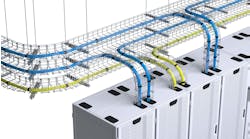COVID-19 has altered our world. In this series of stories, Data Center Frontier explores the strategic challenges the pandemic presents for the data center and cloud computing sectors as we navigate this complex new landscape. We begin with a look at how COVID-19 is impacting demand for digital infrastructure.
The COVID-19 Coronavirus pandemic has reinforced the importance of data centers and cloud computing for our society. In the early days of the crisis, the data center industry has served as the backstop for the global economy, supporting a massive shift to online services for businesses, schools and non-profits.
The pandemic has been a watershed event for the world, and a defining moment for the cloud. For many organizations, a digital transformation that was expected to take years has been compressed into a matter of days and weeks. Entire industries are being reset, and digital infrastructure is front and center in the transition.
What comes next? The data center industry must adjust to a complex new reality. Demand for cloud services will soar in some sectors, but wither in other verticals as they shift into survival mode.
To sort out the evolving picture for data center demand, DCF sought the insights of three prominent securities analysts tracking the data center sector – Jonathan Atkin of RBC Capital Markets, Sami Badri from Credit Suisse, and Colby Synesael of Cowen. All three analysts have surveyed C-suite executives across the industry in recent weeks to assess the impact of the COVID-19 shock.
The consensus is that the data center industry will see strong demand for network services to support the shift to digital platforms, which will likely outweigh any loss of business from sectors that are hard-hit by COVID-19 lockdowns.
A key question is how the pandemic’s evolution will impact data center construction, as well as the ability to conduct tours of properties – both of which will impact the industry’s execution over the long haul.
A Forecasting and Operational Challenge
The outlook for demand for data center space will be more complex than ever. Capacity forecasting has always been a challenge, and the COVID-19 pandemic is impacting different sectors in very different ways. Usage of cloud platforms and streaming media is surging, while business has evaporated for airlines, cruise companies and movie theaters. IT investment in coming months will closely track the fortunes of each business vertical.
On a broad scale, economists expect a historic downturn that will be felt across many sectors. Goldman Sachs projects that advanced economies around the globe will shrink 35 percent in this quarter, four times the previous record decline during the 2008 financial crisis.
“It is very likely that this year the global economy will experience its worst recession since the Great Depression, surpassing that seen during the global financial crisis a decade ago,” the IMF said in a report this week. “The Great Lockdown, as one might call it, is projected to shrink global growth dramatically.”
Digital services have quickly become the most important tool in continuing operations during the massive lockdowns. In forecasting future demand, a complicator is the lack of a clear event horizon for the COVID pandemic, and the need to engineer IT infrastructure for a world in which COVID may rebound, and continuity plans must account for future pandemics.
One milestone will be the development of an effective vaccine for COVID-19, which may not be widely available until early 2021. Until then, epidemiology experts say the U.S. is likely to see continuing outbreaks that could mean rolling lockdowns at the regional or national level. Support is growing for a strategic response built around three pillars: advanced contact tracking, a huge scale-up in testing, and social distancing to contain clusters of COVID-19 cases.
A Divergence in Demand Profiles
The biggest story for the data center sector amid the COVID-19 lockdowns has been strong demand for providers offering essential services – video conferencing apps like Zoom, cloud collaboration platforms, social media, educational portals, VPN specialists, and gaming and streaming media. At the other end of the spectrum, COVID-19 has brought a drastic drop in business for industries like transportation, retail and small businesses. The energy sector has been hit hard by the combo of the pandemic and sharply lower oil prices.
Badri, a Senior Equity Analyst at Credit Suisse, believes the net result will be positive for the data center sector, which explains why shares of industry bellwethers Equinix and Digital Realty hit 52-week highs last week.
“The upside cases are actually higher than any of the drawdowns coming in from the troubled sectors,” said Badri during a CAPRE presentation. “These troubled sectors were not big customers in the first place, whereas the newer industries that represent a large cash flow stream for data centers are flexing even larger than they ever have before. This is creating a new high-tide environment for demand for the overall tech sector.”
Jonathan Atkin of RBC Capital Markets.
Atkin, a Managing Director at RBC Capital Markets, says industry executives are not reporting any significant changes in leasing or customer churn due to economic uncertainty, while experiencing a boost from the shift to digital delivery.
“Based on commentary from every listed operator we spoke to, the industry has seen a real-time uptick from COVID-19 related demand for services,” said Atkin, mentioning connectivity-related offerings such as bandwidth, cross-connects, virtual cross-connects, ports, and cloud on-ramps as the beneficiaries. “In addition, data center operators have seen an increase in demand for remote-hands services due to constraints on labor mobility as well as, in some cases, site-access restrictions or guidelines.”
Synesael, a Managing Director at Cowen, says he expects little change in the outlook for data centers for 2020.
Colby Synesael, Managing Director at Cowen.
“We could argue for upside to long-term demand to the extent it accelerates the shift from on-premise to off-premise, and/or permanently changes behavior such as the use of video conferencing,” said Synesael. “We believe the impact from CV19 is likely to have a greater negative impact on non-interconnect retail providers who cater primarily to mid-sized enterprise customers who at least in the near-term are likely to pullback on signing new deals.”
Although most of the early focus has been on provisioning more network services, that will implications for colocation footprints eventually, Synesael said.
“Customers can only ramp bandwidth to a point before outstripping its provisioned capacity, which would translate into a need for incremental space,” he noted.
A Permanent Change Emerging From Crisis?
While most of the demand gains are led by cloud platforms and SaaS providers, Badri said the pandemic could drive structural IT changes from organizations that have put off modernization.
Sami Badri, Senior Equity Analyst at Credit Suisse.
“Some industries have never been well architected to handle work from home or organize a virtual workforce,” said Badri. “Three of those sectors are healthcare, government and education. We’ve been hearing that government IT spending pledges alone are up more than 20 percent. Education budgets are also increasing and shifting up. Other categories playing catch-up include healthcare, which has been a very big pain point for the U.S.
“(These sectors) are making investments with the realization that they should have done this all along, and instead they cut corners,” he added. “Now they are making a more permanent investment for the long term, not just in response to COVID-19, but for overall ICT infrastructure and architecture optimization for the way they are now consuming applications.”
One concern that is being expressed across the board is the difficulty of acquiring new customers in an environment that leaves little room for data center tours. Virtually every provider is limiting access to their facilities by customers and vendors in order to limit the spread of COVID-19 and ensure that mission-critical staff are not infected.
Tours are an important step for buyers as they compare providers and facilities, given the mission-critical nature of the assets that they will entrust to the service provider. This is reflected in recent data center designs that allow prospects to visualize all aspects of the facility without ever having to enter a secure area.
“How do you lease large amounts of colocation space in a world where you’re not free to travel to tour the facility and meet with the salespeople and engineers that are so critical to this decision?” said one industry executive.
Over the longer term, there is the possibility that pandemic-related slowdowns in data center construction could lead to capacity constraints for specific markets and providers. We will take a deeper look at this issue in the next story in our series.
Scalability Boosts Cloud Platforms
For some requirements, cloud platforms will become more attractive, as crisis places a premium on speed and scalability, according to 451 Research:
“At times like this, the scalability of the cloud really comes into its own,” 451 says in an analysis of cloud economics. “As the behavior of the populace changes as a result of the virus and approaches to its management, we can expect some web applications to explode with traffic, while others might dwindle to near nothing. … Scalable cloud applications should be able to grow and shrink to meet this changing demand automatically. For those suffering from lower hits, scaling down at least saves a bit of cash – a silver lining in challenging times. For those experiencing a surge, the cloud lets websites continue to perform under pressure.
Crucially, this scaling can be configured automatically, with no need to forecast or plan capacity. With public cloud, the cloud provider – not the enterprise – is responsible for capacity. Conversely, many private clouds will sit unutilized in datacenters, while others will be overwhelmed as demand exceeds the steady-state capacity expectation.”
While the COVID-19 crisis should eventually recede, its impact will be with us for some time to come.
“Virtual connectivity is a must,” said Badri. “It’s no longer a debate. It’s now a case of survival and relevance and productivity. You’re starting to see permanent shifts.”










